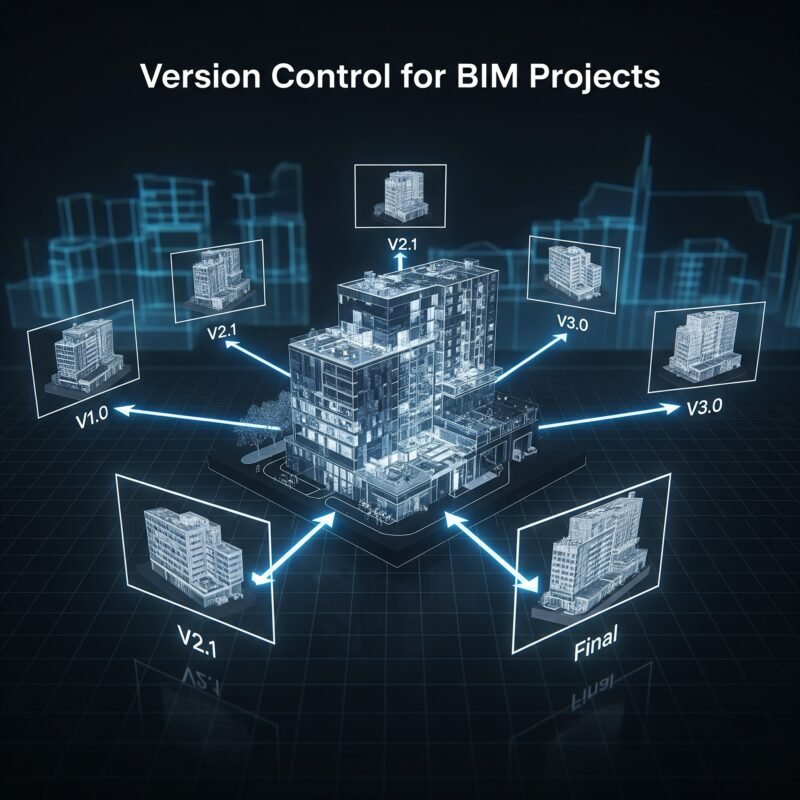XML vs JSON in BIM Data Exchange
XML vs JSON in BIM Data Exchange
Choosing between XML and JSON for BIM data exchange? Here’s the key takeaway: XML excels in handling complex, hierarchical data and offers built-in validation, making it ideal for enterprise-level BIM workflows. JSON, on the other hand, is lightweight, faster, and perfect for real-time web-based collaboration.
Key Differences at a Glance:
- XML: Best for detailed documentation, validation, and legacy systems.
- JSON: Suited for web APIs, mobile apps, and cloud-based workflows.
Quick Comparison:
| Feature | XML | JSON |
|---|---|---|
| File Size | Larger due to verbose tags | Smaller and compact |
| Validation | Native (XSD/DTD) | Requires external tools |
| Readability | Detailed but verbose | Concise and simpler |
| Browser Support | Needs external libraries | Native in JavaScript |
| Use Case | Complex hierarchies, compliance | Web-based, real-time tasks |
When to use XML: Complex projects needing strict validation and documentation.
When to use JSON: Fast, lightweight data exchange for modern web tools.
For BIM workflows, a hybrid approach often works best – XML for core data and JSON for real-time updates.
XML in BIM Data Exchange
XML Structure and Format
XML uses a hierarchical structure to organize BIM data with nested tags. These tags define components like <wall>, <window>, and <door>, along with their properties (as nested elements or attributes) and relationships. A typical XML file includes a structured header containing metadata, such as project details, which aligns well with BIM’s object-oriented framework.
XML Benefits for BIM
XML provides several advantages when used for BIM data exchange:
| Benefit | Description | Impact on BIM Workflows |
|---|---|---|
| Schema Validation | Ensures data follows set rules | Maintains consistency across platforms |
| Self-Describing | Tags offer clear context | Makes data easier to interpret |
| Wide Support | Works with many BIM tools | Facilitates smooth data sharing |
| Extensibility | Customizable for specific needs | Accommodates unique project requirements |
XML Constraints in BIM
While XML has its strengths, it also comes with some challenges in BIM:
- File Size: The verbose nature of XML tags can lead to large files, which may complicate storage and transfer.
- Processing Speed: Parsing detailed tags requires more computational resources, slowing down workflows for large projects.
- Learning Curve: XML’s strict syntax and schema rules can be difficult for new users to master.
- Version Control: Its text-based format can make tracking changes in collaborative environments more complex.
To mitigate these issues, teams may use techniques like compressing files or splitting large models into smaller XML files to improve performance. Up next, we’ll look at how JSON provides a more streamlined solution for web-based BIM workflows.
JSON in BIM Data Exchange
JSON Structure and Format
JSON (JavaScript Object Notation) organizes BIM data using key-value pairs. It employs nested structures and arrays that align directly with BIM elements and their properties. Here’s an example of how a BIM component might look in JSON:
{
"wall": {
"id": "W101",
"height": 108.27,
"width": 48.0,
"material": "concrete",
"properties": {
"fireRating": "2HR",
"thermalValue": "R-19"
}
}
}
This simple format makes it easier to work with BIM data in various applications.
Advantages of JSON in BIM
JSON’s structure brings several benefits to BIM workflows:
| Advantage | Description | BIM Application |
|---|---|---|
| Lightweight Structure | Smaller file sizes compared to XML | Speeds up cloud-based collaboration |
| Native Web Support | Can be directly parsed by browsers | Enables web-based BIM viewing |
| Easy to Modify | Data is simple to update | Allows quick adjustments to components |
| Human-readable | Clear and straightforward format | Simplifies debugging and troubleshooting |
Limitations of JSON in BIM
Despite its strengths, JSON has some drawbacks when applied to BIM:
- Limited Data Types: JSON supports fewer native data types than XML, which can make representing complex BIM geometries more difficult.
- No Built-in Validation: Unlike XML, JSON lacks schema validation, requiring external tools to ensure the data structure is correct.
- No Comments: JSON doesn’t allow for embedded documentation within the data itself.
- Reference Challenges: Representing bidirectional relationships between BIM elements can be tricky in JSON.
Because of these limitations, many BIM platforms use a hybrid approach – leveraging JSON for fast, real-time data exchange while relying on XML for detailed project documentation.
API Formats: Why JSON won over XML
sbb-itb-0af4724
XML vs JSON: Direct Comparison
The table and details below highlight the differences between XML and JSON, particularly in BIM workflows.
Feature Comparison Table
| Feature | XML | JSON | Impact on BIM Workflows |
|---|---|---|---|
| File Size | Larger due to tags and attributes | Smaller and more compact | Smaller files in JSON enable quicker data transfers in cloud-based BIM collaborations. |
| Data Types | Supports complex types via XML Schema | Basic types like strings, numbers, etc. | XML provides detailed type definitions, while JSON is better for simpler data structures. |
| Schema Support | Built-in with XSD and DTD | Requires external schema validation | XML’s built-in schema ensures data integrity in BIM models. |
| Validation | Native support (DTD/XSD) | Needs external tools | XML’s native validation ensures consistent data exchange. |
| Readability | Detailed but verbose | Concise and easier to edit | JSON is quicker to modify, while XML provides clarity through its structure. |
| Browser Support | Needs external libraries | Native in JavaScript | JSON is ideal for web-based BIM viewers due to its compatibility. |
| Learning Curve | Complex syntax | Simple and intuitive | JSON’s simplicity helps new developers integrate faster into BIM workflows. |
| Memory Usage | Higher memory requirements | Lower memory usage | JSON’s efficiency benefits resource-limited BIM applications. |
Main Technical Differences
Beyond basic features, XML and JSON differ significantly in how they handle data, processing, and security in BIM workflows.
-
Data Structure Representation
XML organizes data in a hierarchical tree structure, making it suitable for complex BIM hierarchies. It also supports namespaces, which are critical for managing multidisciplinary projects. JSON, on the other hand, uses an object-based structure that aligns closely with programming data types, offering simplicity for straightforward use cases. -
Processing and Integration
XML supports tools like XPath and XSLT for querying and transforming data, making it a good fit for legacy systems and SOAP protocols. JSON, however, is designed for speed, with fast parsing in modern programming environments. It integrates seamlessly with REST APIs and web frameworks, making it a popular choice for web-based BIM tools. -
Security Considerations
XML includes built-in standards for features like digital signatures, providing robust options for data validation and change tracking. JSON requires additional external measures to achieve similar levels of security, which can impact its use in sensitive BIM projects.
Format Selection Guide
Choose the format that aligns with your BIM workflow requirements based on their specific strengths.
When to Use XML
XML works well for:
- Enterprise-level projects requiring strong validation and detailed documentation.
- Meeting building code compliance and audit standards.
- Integrating with legacy BIM systems.
When to Use JSON
JSON is ideal for web-focused BIM tasks, such as:
- Real-time collaboration on web-based platforms.
- Mobile BIM applications where bandwidth is limited.
- API-driven workflows using REST or microservices.
Combining XML and JSON
You can improve efficiency by using both formats in complementary ways:
- Hybrid Systems: Use XML for storing core model data, while JSON handles real-time UI updates.
- Format Conversion: Store data in XML, convert to JSON for interactive processes, and revert to XML for final validation.
- Service Integration:
- XML for complex core BIM operations.
- JSON for client-facing web services.
- Use translation tools to bridge the two formats.
Conclusion
Format Comparison Summary
When it comes to BIM data exchange, XML and JSON each bring specific strengths to the table. XML is better suited for enterprise-level tasks like data validation and documentation, while JSON shines in modern, web-focused workflows.
Here’s a quick breakdown of what sets them apart:
- XML: Ideal for handling complex metadata and ensuring structured data validation, thanks to its hierarchical format.
- JSON: Offers smaller file sizes and quicker parsing, making it a perfect fit for web APIs and JavaScript-based tools.
- XML: Works well with systems that demand strict data validation.
- JSON: Seamlessly integrates with modern web development environments.
These distinctions play a key role in determining the right format for your BIM workflows.
Recommendations
To ensure smooth BIM data exchange, follow these steps:
- Assess your project’s requirements for validation, documentation, and system integration.
- Take stock of your current systems, tools, and your team’s expertise.
- Choose formats that align with both current needs and future scalability.
For organizations aiming to refine their BIM workflows, BIM Heroes offers specialized consulting services. Their expertise in BIM documentation and data management can simplify the exchange process while ensuring compliance with global building standards.
Using both formats strategically can improve BIM interoperability. Careful format selection is a critical factor in strengthening data exchange workflows.





